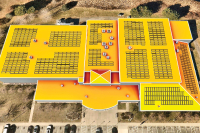Jackson schools map out millions in capital needs
 Jackson County Public Schools wants more than $12 million for improvements to its facilities through 2020, but despite the big number, the requests are pretty basic, Superintendent Mike Murray told commissioners last week.
Jackson County Public Schools wants more than $12 million for improvements to its facilities through 2020, but despite the big number, the requests are pretty basic, Superintendent Mike Murray told commissioners last week.
“There’s some point where you say it’s just not right to have kids sitting with buckets in classrooms,” Murray said.
Roofs, heating and athletics
A significant chunk of the $12.6 million ask — a number which is not final and includes projects funded through the budget approved in July — would go to replace failing roofs at five schools in the district, a $2.8 million undertaking. Most of the roofs are 20 or more years old, so given that the standard life of a roof is around 25 years, it’s time to start planning for replacements before failures happen.
In some cases, it’s been too late. Commissioners had to appropriate $190,000 in emergency funds this year when part of the roof at Fairview Elementary School unexpectedly failed. The same thing happened at Cullowhee Valley Elementary School in 2013. In that case, Murray said, it appears something was up with the design — the roof should have lasted longer.
“We should have got another 10 years out of that roof,” Murray said. “There’s no reason in the world that it failed when it did.”
Related Items
Another big piece of the requested funding is for heating, ventilation and air conditioning renovation, accounting for $2.9 million of the five-year estimate. Looking further ahead, the school system knows it will need to renovate the system at Fairview in year six. There’s no estimate for that project yet, but it will likely come in over a million dollars. The HVAC plan is another one of those expensive but necessary improvements, Murray said — not glamorous, but vital to the function of the schools.
“We put away the wish list and looked at things to keep the roof over our heads,” he told commissioners.
SEE ALSO: Capital needs
Other non-glamorous items in the plan include grading, paving and gate installation for the bus garage and connection to the tribal water system at Smoky Mountain Elementary. The school district doesn’t have a hard estimate for those projects yet, but together they will cost at least $150,000, likely more.
That’s not to say that the five-year plan is strictly about roofs, heating and water. It also includes more than $3 million for athletic facilities such as tennis courts, artificial turf, a baseball field and a new track at Smoky Mountain High School. If it were fully funded, the final expense could be much more, as the plan includes alternate options with higher price tags and pieces of it are currently without estimates.
Having adequate sports facilities is important when it comes to offering a well-rounded education and giving students in Jackson County the same opportunities as their counterparts elsewhere, Murray said. And in a climate of increasing competition for students — from private, charter, online and home schools — it’s becoming ever more important to stay a step ahead in the opportunities the public schools can offer.
But funding is never unlimited, so fixing leaky roofs and failing heating systems will always come before building new tennis courts and baseball fields, he said.
“We’re not going to be putting tennis courts in when I have a roof leaking,” Murray pledged to commissioners.
The list of hoped-for improvements is prioritized within each year, with roofs and HVAC projects always coming before athletic facilities, pointed out Assistant Superintendent Kim Elliott.
“If there’s an athletic wish in a list, it would be if the rest of the project were fully funded,” she said. The district would “frankly need to seek other funding” if it really wanted to get all the athletic projects on the five-year plan completed, she added.
One of those athletic projects could rise to the top of the priority list, however: artificial turf for the high school football field. But that’s because the school system secured a competitive grant — one of 17 awarded nationwide — from the NFL that would put $200,000 into the project. The school system is currently waiting on the outcome of a report estimating the total cost for the project and repairs to the track, which would have to be disturbed to install the turf. Murray has made it clear the school board is willing to commit only $515,000 of taxpayer money to supplement the grant dollars. It would still be an expensive project, and while some community members have spoken out against the possible expenditure, Murray believes artificial turf would earn its keep by accommodating more teams more frequently than natural grass fields.
This is the second year in a row that Murray has presented commissioners with a version of the five-year plan, with the $1.6 million allocated for the current budget year included in the $12.6 million five-year estimate. The year one projects have been budgeted for, though only two — reroofing Cullowhee Valley and replacing water pipes at the School of Alternatives — have actually been awarded a contract. The costs, as with the rest of the price tags attached to projects on the five-year plan, are only estimates.
Finding the money
Now the discussion involves how to fund year two.
Last year, Murray had asked for $3.3 million to replace roofs, water pipes, renovate the HVAC system at the high school and update its athletic fields. Commissioners funded only about half of that request, so most of the unfunded items from last year got shoved to the list for 2016-17.
“What we’re funding now, we’re not going to get into that list before we’re back around with another list,” said County Manager Chuck Wooten.
The county automatically funds $235,000 per year to help with general capital maintenance, something that Murray termed “a wonderful gesture,” but he made it clear that holding the line there won’t be enough to take care of the imminent capital needs facing the schools.
The county also has revenue from sales tax at its disposal to help with school needs. About $1.4 million from that pot is available, not already committed to another project. But it’s not looking like that will be enough to get done what needs to get done, Wooten said. He suggested that commissioners consider borrowing money or taking from their savings account to close out the school system’s list as soon as possible.
“On a pay-as-you-go basis, we’re never going to be able to get this list off the table before we have a building issue,” Wooten said.
Using the county’s savings account could be a viable option, Wooten said. The account, referred to as a fund balance, has been growing — it now holds about 25 percent of the funds needed to get through an entire year of county operations. The state mandates that counties keep at least 8 percent of the annual budget in the account.
“We could use some of that fund balance and not jeopardize our financial position at all,” Wooten said.
Another option would be to take out a loan. Over the next five years, county payments on existing debt are expected to decline by about $70,000 a year as debts are paid off. If the county paid $1.4 million toward the five-year plan outright this year, it could take out a loan for all or some of the remaining $11 million needed to fulfill the estimate for the five-year plan. The debt payments on $11 million would come out to about $1 million per year.
When Murray came to commissioners last year, he’d favored a gradual replacement schedule for the roofs to prevent the situation the district’s finding itself in now from coming around again. If you replace all the roofs at once, the reasoning went, the replacement needs will once again pile up 25 years down the road.
He’s changed his tune.
“When you’re marketing your building (to parents) and you have buckets sitting there, it isn’t good,” Murray said. “I would much rather see us catch up and set so much aside for roofs every year. That to me is a smarter way to go.”
And, as Commission Chairman Brian McMahan pointed out, the plan before them now looks only five years ahead. It could be dangerous to let things pile up too far beyond that timeframe.
“What would be the next needs beyond the five-year plan?” he asked. “Do we even have an idea of that?”
Hard to say, Murray responded.
“Across the state of North Carolina, that’s about unpredictable. I’m sure if you asked Haywood County several years ago, they would not find themselves shutting down a school,” he said, referring to the neighboring county’s vote to look at closing Central Elementary School to offset a budget shortfall.
No decisions have been made thus far about what to fund or how to fund it, with commissioners indicating they’d start discussing those choices in-depth at their February work session. But school district leaders left feeling optimistic.
“I believe that the five-phase plan has been recognized for what it is — that is, critical needs mainly focused on roofs and mechanics, and I appreciate the fact that we were heard,” Elliott said. “I believe the county commissioners will work to ensure the plan is implemented in some fashion. I left there feeling very positive.”









